Here we show some telephotos of the site and the part of the ancient installations that are not included in the archaeological site within the enclosure. There are also some photos of a model of the archaeological site, as well as some plans of it.
Here follows an index list with the names of each numbered monument.
The Sanctuary Of Delphi Site Plan
| 1. Roman Agora (Social Gathering and Marketplace) |
15. Treasure House of Athens |
29. Spring |
| 2. Votive offering of Corfu ("Bull") |
16. Bouleuterion (Council House) |
30. Temple of Apollo |
| 3. Votive offering of Athens ("Victory at Marathon") |
17. Treasure House of Cnidus (Knidos) |
31. Votive Tripods |
| 4. Votive offering of Lacedaemonians (Aigos Potamoi Victory) |
18. Rock of Sibylla |
32. Treasure House of Acanthus |
| 5. Votive offering of Argos ("Seven Against Thebes") |
19. Naxian Column |
33. Portico of Attalus |
| 6. Votive offering of Argos ("Descendants") |
20. Asklepion |
34. Shrine of Neoptolemos |
| 7. Votive offering of Argos ("The King of Argos") |
21. Portico of the Athenians |
35. Votive offering of Daochos |
| 8. Votive offering of Taras |
22. Treasure House of Corinth |
36. Club of the Cnidians |
| 9. Treasure House of Sikyon |
23. Prytaneion (Magistrates' Building) |
37. Kassotis Spring |
| 10. Treasure House of Siphnos |
24. Treasure House of Cyrene |
38. Ischegaon-Supporting Wall |
| 11. Treasure House of Megara |
25. Supporting Polygonal Wall |
39. Votive offering of Krateros |
| 12. Treasure House of Thebes |
26. Tripod of Plateae |
40. Theater |
| 13. Treasure House of Boeotia |
27. Votive offering of Rhodes |
41. Western Portico |
| 14. Treasure House of Potidaea |
28. Grand Altar |
'
|
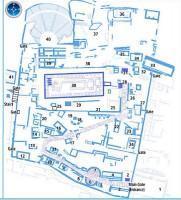
Delphi Archaeological Site Plan
The main gate, used also today, is on the bottom right. The Sacred Way starts here and leads to the Temple of Apollo. The Stadium and the area around it are not included. The list with the names of the numbered monuments is to be found higher up in this page.
credit: Based on a map shown in delphi-greece.blogspot.com |
|
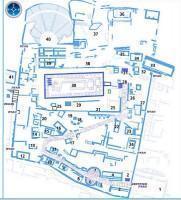
Delphi Archaeological Site Plan For our Greek-speaking visitors
credit: Based on a map shown in delphi-greece.blogspot.com |
|
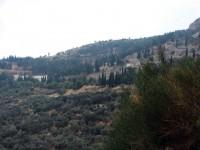
The Sanctuary on a gloomy day
The Museum building is seen to the left, the Treasury of the Athenians higher up to its right and the columns of the Temple of Apollo to the right of the photo. |
|
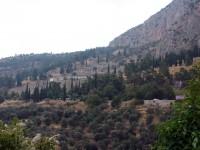
The Sanctuary on a gloomy day
The Treasury of the Athenians and the columns of the Temple of Apollo. Lower down one can discern the road running along the front of the archaeological site. |
|
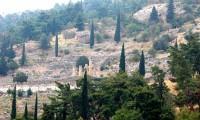
The Sanctuary on a gloomy day
A tele-photo of the Temple of Apollo. |
|
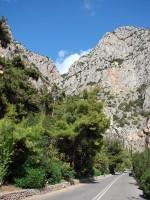
The Sanctuary of Delphi
The road mentioned in a previous photo. It goes straight to the ravine between the Phaedriades rocks, where the Castalian Spring is still flowing, and then turns to the right, away from it. This spring was considered to be sacred because, according to the myth, it was here that Apollo killed Python, the serpent-monster. All visitors of the sanctuary used to wash their hair here. |
|
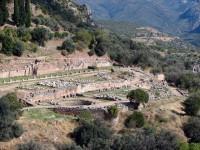
The Sanctuary of Apollo in Delphi: The Gymnasium
Photo of the Gymnasium, half a mile away from the main sanctuary. It was here that the youth of Delphi kept their body in condition. It consisted of a series of buildings in two levels: a portico higher up and a palaestar with bathing facilities (pools and baths) a bit lower down. These pools and baths were said to have magical powers, and imparted the ability to communicate to Apollo himself. To the far right, the ruins of Athena Pronaia Tholos are also visible. |
|
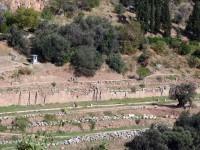
The Sanctuary of Apollo in Delphi: The Gymnasium |
|
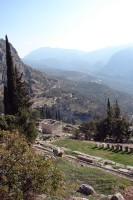
The Sanctuary of Apollo in Delphi: The Treasury of the Athenians photographed from high up in the archaeological site
The valley of Pleistos river, full with olive trees, is also visible in the background. Please notice the Mediterranean Cypress-trees ornamenting the site. |
|
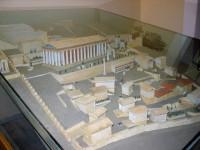
Delphi Model of the Archaeological Site (2nd century A.D.): General View
This model reproduces the Apollo Sanctuary as described by the 2nd century A.D. traveler, Pausanias. The Oracle is surrounded by ancient Wall, which is exactly above the main road. According to researchers, the ancient town used to be around it but it has not been adequately studied and thus, not included in this reproduction.
Positioning of the numerous important monuments in this model has been made according to the latest research on the Sanctuary. On both sides of the Holy road there are reproductions of the ancient well-known offerings, of which only the foundations exist today (Only one wooden offering was found in the sanctuary). |
|
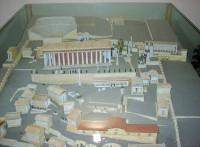
Delphi Model of the Archaeological Site: General View
...excluding the Main Entrance and the beginning of the Sacred Way, at the bottom of the photo |
|
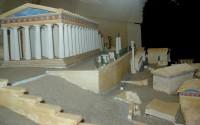
Delphi Model of the Archaeological Site: The Temple of Apollo |
|
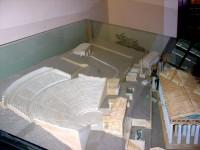
Delphi Model of the Archaeological Site: The Theater |
|
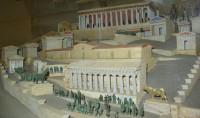
Delphi: Model of the Archaeological Site
In the front, flanked by bronze statues one can see the Sacred Way running past the Stoa (Portico) of the Lacedaemonians and heading to the Treasure of the Athenians (the small temple-like edifice facing us on the left of the photo). To the left of the prenamed portico, we can see a cemi-circular exhedra, with votive offerings of Argos (the King of Argos); on the top, the Temple of Apollo. |
|
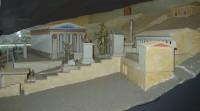
Delphi: Model of the Archaeological Site: The Temple of Apollo |
|
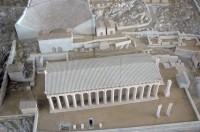
Delphi Model of the Archaeological Site: The Temple of Apollo |
|
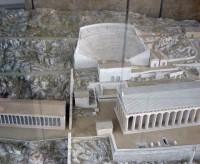
Delphi Model of the Archaeological Site: The Temple of Apollo and the Theater
To the left, the Western Stoa (Portico) |
|
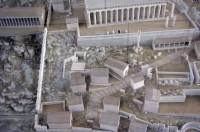
Delphi Model of the Archaeological Site: The area east of the Temple of Apollo |
|



